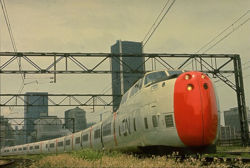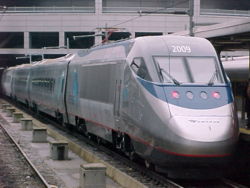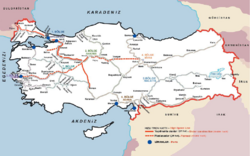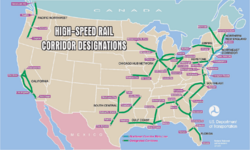Planned high-speed rail by country
This article provides of planned or proposed High-speed rail projects, listed by country. High-speed rail is public transport by rail at speeds in excess of 200 km/h (125 mph). [1] For details of proposed or planned extensions or upgrades to existing high-speed rail networks, or details of current high-speed rail networks, see high-speed rail by country.
Europe
Austria
The Austrian Western Railway is being upgraded and partially rebuilt, and will in future allow the German ICE trains currently running on the line to break the 200 km/h barrier.
Netherlands
The Dutch HSL-Zuid line is currently under construction. Connecting the Netherlands with Belgium and France, it will carry both the TGV-derived Thalys and domestic high-speed trains. Beside it a high-speed track to Groningen is being studied.
Russia
The Moscow-Saint Petersburg Railway is being updated to allow German ICEs, bought by Russia, to reach 250 km/h (150 mph) by 2008. Construction started in 2004 and work is expected to be completed in 2008. Finland and Russia have agreed on a high speed rail line linking Helsinki and St. Petersburg with Finland's Pendolinos, time will be cut from 5.5 hrs to 3.5hrs, due to be completed in 2008.
Sweden
Sweden today runs many trains at 200 km/h, including the X2 tilting trains, widebody and double-decker regional trains, and the Arlanda Airport Express X3. The X2 runs between main cities like Stockholm, Gothenburg, Malmö and the Arlanda Express trains run between Stockholm and Arlanda airport. Hundreds of kilometres of track are ready for 250 km/h operation, with the exception of the signalling system, catenary, and the trains. A test train, called "the Green Train" is being tested at up to 280 km/h [1]. Around year 2015 a 180 km long part of the railway Stockholm-Malmö will run at 250 km/h speed.
Other railways that later will allow 250 km/h (today 200 km/h) are long parts of Stockholm-Gothenburg, Gothenburg-Malmö, and some under construction: Trollhättan-Gothenburg and the Bothnia Railway, Botniabanan. [2].
There are proposals for long completely new high-speed railways Jönköping-Helsingborg and Stockholm-Linköping-Jönköping-Gothenburg, since the existing railways are relatively congested, with mixed 200 km/h passengerer trains, slower regional trains and even slower cargo trains. These proposals are relative far into the future, although Stockholm-Linköping (Ostlänken) seems to be built before 2020.
Switzerland
Switzerland has no high-speed trains of its own yet. French TGV and German ICE lines extend into Switzerland, but given the dense rail traffic and the short distances between Swiss cities they currently do not attain speeds higher than 160 km/h there.
The fastest Swiss trains are the ICN tilting trains, operated by the Swiss Federal Railways since May 2000 and capable of 200 km/h even on the curve-intensive Swiss network. The Cisalpino consortium owned by the Swiss Federal Railways and Trenitalia uses Pendolino tilting trains on two of its international lines.
The Rail2000 project (first stage) finished in 2005, included a new high-speed rail track between Bern and Olten with an operating speed of 200 km/h.
AlpTransit project is building faster north-south rail tracks across the Swiss Alps by constructing base tunnels several hundred metres below the level of the current tunnels. The 35 km Lötschberg Base Tunnel will open in 2007 where new Pendolino 4 trains will run at 250 km/h. The 57 km Gotthard Base Tunnel (Top speed 250 km/h) is scheduled for opening in 2015.
The second stage of Rail2000 includes line upgrades in canton Valais (200 km/h) and betweend Biel and Solothurn (200 km/h). Start of work is 2012.
Turkey
- For more details on this topic, see High-speed rail in Turkey.
Turkey has started building high-speed rail lines in 2003. The first line, from İstanbul (Turkey's largest city) via Eskişehir to Ankara (capital of Turkey), is under construction and will open in 2007 reducing the traveling time from 6–7 hours to 3 hours 10 minutes. The Ankara - Konya line began construction in 2006. A travel time of 70 minutes is foreseen for this track. Several other lines between major cities such as Ankara - Afyon - Uşak - İzmir, Ankara - Yozgat - Sivas, İstanbul - Bursa, İstanbul - Kapıkule (Bulgarian border) are planned to be built in coming years. The commercial high speed trains are expected to reach a top speed of 250-300 km/h (150-200 mph). The first 10 high speed train sets are ordered from CAF company, Spain. For further sets to be used in new planned tracks and the current ones under construction, EUROTEM, a joint enterprise between Korean ROTEM and Turkish TÜVASAŞ had been established, and a factory in Adapazarı,Sakarya had been founded.
North America
Canada

High-speed rail in Canada is more a case of hope than reality. Canada placed some early hopes with the United Aircraft Turbo train, in the 1960s. The train sets achieved speeds as high as 200 km/h in regular service, but for most of its service life (marred with lengthy interruptions to address design problems), it ran at a more realistic 160 km/h.
Beginning in the 1970s, a consortium of several companies started to study the Bombardier LRC, which was a more conventional approach to high-speed rail, in having separate cars rather than being an articulated train. Pulled by heavy conventional-technology diesel-electric locomotives designed for 200 km/h normal operating speed, it entered full-scale service in 1981 for VIA Rail, linking cities in the Quebec City-Windsor Corridor, but at speeds never exceeding the 170 km/h limit mandated by line signalling.
In 1998, the Lynx consortium, including Bombardier and SNC-Lavalin proposed a 300 km/h high-speed train named the Jet-Train from Toronto to Quebec City via Montreal based on the TGV and the french Turbo-Train technology. Recently, Bombardier and VIA have proposed high-speed services along the Quebec City-Windsor Corridor using Bombardier's experimental JetTrain tilting trains, which are similar to Bombardier's Acela Express, but powered by a small jet engine rather than overhead electric wires. These trains ressemble the first TGV prototype (TGV001) powered by a gas turbine that were tested on the Strasbourg-Mulhouse line. As yet, no government support for this plan has been forthcoming, and Bombardier continues promoting the JetTrain especially for Texas and Florida routes.
Bombardier has also recently promoted high-speed rail in the province of Alberta between Edmonton and Calgary. On September 22nd 2006 it was announced the Provincial government was deploying video cameras along a stretch of the Queen Elizabeth II Highway as to help determine the merits of building the Calgary/Red Deer/Edmonton link. Further driver surveys will better help understand the nature of the 50,000 car trips between the 3 cities [3].
United States

The United States placed some early hopes in high-speed trains with the Acela, Acela runs at between 75 mph (120 km/h) and 150 mph (241 km/h), Acela Express (often called simply Acela, leading to early confusion with the Acela Regional and Acela Commuter) is the name used by Amtrak for the high-speed tilting train service operating between Washington, D.C. and Boston via New York City and Philadelphia along the Northeast Corridor (NEC) in the Northeast United States. The tilting design allows the train to travel at higher speeds on the sharply curved NEC without disturbing passengers by lowering lateral G-forces. Acela Express trains are the only true high-speed trainsets in the United States. This has made the trains very popular, and by some reckoning, Amtrak has captured over half of the market share of travelers between Washington and New York.[2] Outside of stations, Acela runs at between 75 mph (120 km/h) and 150 mph (241 km/h), depending on track conditions.
It is possible to trace the development of high-speed railways back to the streamliners that criss-crossed the U.S. in the 1930s, 1940s, and 1950s which, in turn, can be traced further back to the competing companies operating different routes between London and Scotland, and to railways in Germany and France. There has been a resurgence of interest in recent decades, with many plans being examined for high-speed rail across the country, relegated to Amtrak's Northeast Corridor between Boston and Washington, D.C. (the service covers New York City and Philadelphia).
In 2002, the Texas High Speed Rail & Transportation Corporation [4] (THSRTC), a grass roots organization dedicated to bringing high speed rail to Texas was established. In 2006 American Airlines and Continental Airlines formally joined THSRTC, in a effort to bring high speed rail to Texas as a passenger collector system for the airlines.
The California High Speed Rail Authority was created in 1996 by the state to implement an extensive 700 mile (1127 km) rail system. Construction is pending approval of the voters during the November 2008 general election, in which a $9 billion state bond would have to be approved. If built, the system would provide a TGV-style high-speed link between the state's four major cities, and would allow travel between Los Angeles' Union Station and San Francisco's Transbay Terminal in two and a half hours.
Mexico
The Secretariat of Communications and Transports of Mexico is currently building a high-speed rail link that will transport its passengers from Mexico City to Guadalajara with stops in the cities of Querétaro, and Irapuato. The construction of the rail started in late 2005 and it's expected to be finished in late 2007 or early 2008. The train will allow passengers to get from Mexico City to Guadalajara in just 3 hours at an affordable price (the same trip by road would last 5 hours). The SCT is working together with the french rail company Systra to finish this ambitios project to introduce high-speed rail to Mexico. There is another rail that will serve Mexico City and its Metropolitan area which will be called "Tren Suburbano". This rail will contect to the one that will connect Mexico City, Querétaro, Irapuato, and Guadalaja together. The whole project costed 12 billion pesos.
South America
Argentina
The Buenos Aires-Rosario-Córdoba high-speed railway was announced in 2006 by the national government. The high speed line between Retiro station in Buenos Aires and the city of Rosario, would be the first of its class in South America, with a lower-speed extension to the city of Córdoba. Work is projected to begin in 2007 [5]. It is expected to be completed in 2010.
Brazil
Bids are expected to be invited soon for a standard-gauge high-speed (280 km/h) line linking Rio de Janeiro and São Paulo. The line would be more than 400 km long, and could partly follow existing rights of way. It would cost about US$8 billion. Preliminary designs have already been completed by Odebrecht, Brazil; Siemens, Germany; and Italplan, Italy. http://findarticles.com/p/articles/mi_m0BQQ/is_2_46/ai_n16070991
Australia
Australia has no high-speed trains. The Transwa Prospector operating between Perth and Kalgoorlie is capable of reaching 210 km/h however operates at 160 km/h due to poor track conditions. Queensland Rail's electric Tilt Train between Brisbane, Rockhampton and Cairns is believed to be the fastest narrow-gauge railway in the world at record breaking speeds of 210 km/h (130.4 mph). The service to Cairns is a diesel tilt train, as the line is not electrified.
The development of Australia's railways has always been hampered by the country's low population density; it has a population comparable to a small European country such as the Netherlands yet occupies an area only slightly smaller than the mainland United States. With the consequent deregulation and intense competition in the domestic airline industry, the cheapest method of travel between the major population centres is by air. While car fuel is not taxed as lightly as in the United States, it is still much less expensive than in European nations, which greatly reduces the appeal of train travel and the hope of significant expansions in the near future.
There have, however, been discussions of a high-speed railway between Sydney and Canberra, which could ultimately expand into a corridor extended from Sydney to Brisbane and from Canberra to Melbourne and Adelaide. [6]
For a history of high-speed rail proposals and discussions in Australia, see [7]
Asia
Pakistan
The cities of Rawalpindi and Lahore will be getting an upgrade to a high speed rail track with trains reaching speeds upto 200 km/h. Currently this track is capable of reaching a top speed of 100 km/h. A direct train between Lahore and Karachi will commence operations from July 26th 2006 and will reach a top speed of 140 km/h and will be equipped with VHF walkie-talkies. Pakistan railways have laid all welded new and heavier rails fixed with latest fastenings to upgrade the back. Currently, the government is in negotiations with German companies to start bullet trains for the Lahore-Karachi and Karchi-Islamabad route.
Israel
A new high-speed rail line between Jerusalem and Tel Aviv, cutting travel time between the two cities to 28 minutes (currently about 75 minutes), is under construction by Israel Railways and expected to begin service in 2011. In addition, the entire railway system is currently undergoing extensive upgrades and electrification, so that by early in the next decade, all three major metropolitan areas (Haifa, Jerusalem, and Beer Sheva) which are located outside the center of the country will be reachable within about thirty to forty minutes of Tel Aviv.
India
Some projects have been developed within medium and long-term time frames. They include lines radiating from New Delhi to Amritsar, Jaipur, Agra (Taj Mahal), and Kanpur; Mumbai to Ahmedabad; Calcutta to Dhanbad; Chennai to Bangalore and Mysore; and Chennai to Hyderabad, Vijayawada, and Visakhapatnam. These 'Shatabdi'-class trains are usually non-stop and can reach a maximum speed of 140 km/h, thus higher speed but not "high speed rail".
Japan's trade minister has pledged Japan's cooperation with India to create a high speed link in India between New Delhi and Mumbai. [3]. This was agreed during the Indian Prime Minister's visit to Japan in December, 2006.
Iran
There is one high-speed rail line project in Iran between Tehran and Isfahan, as well as Gorgan to Mashhad and Qom to Tehran.
Japan
A Japanese consortium led by the Central Japan Railway Company have been researching new high-speed rail systems based on magnetic levitation since the 1970s. Although the trains and guideways are technologically ready and over 100,000 people have ridden them, high costs remains as barriers. Test trains JR-Maglev MLX01 on the Yamanashi Test Line have reached speeds of 581 km/h (crewed), making them the fastest trains in the world. These new maglev trains are intended to be deployed on new Tokyo–Osaka Shinkansen maglev route, called the Chuo Shinkansen, though the project has no political support, due to a spiralling Japanese national debt.
A new generation of conventional steel wheeled Shinkansen trains FASTECH 360 with a top speed of 405 km/h and an operational speed of 360 km/h is currently under development. Production trains are expected to enter service in 2011. Regenerative braking and hybrid electric technology has been studied for use on Shinkansen trains.
Malaysia-Singapore
There is a bullet train project at 300 km/h proposed to link Kuala Lumpur and Singapore, proposed by current high(er) speed rail (160 km/h) operator KLIA Express YTL, which links Kuala Lumpur with the KLIA. Travel time -90 Minutes, as compared to 4 hours of highway drive, 7 hours currently by standard rail, 2 hours of flight including commuting to and from airport, check in and boarding. It would be the first international line outside of Europe if built. Talks of a Bangkok Singapore line spanning the 3 nations have been suggested previously, though no action has been taken.
Saudi Arabia
A high speed rail project is under study from Mecca to Medina through Jeddah. See also Saudi Railways expansion programme.
Vietnam
Vietnam Railways are planning a 1,630-km (1,010 miles) high-speed link from its capital Hanoi in the north, and second city Ho Chi Minh City in the south, running at 300 to 250km/hr. The funding of the $33 billion line will mostly come from the Vietnamese government, with the help of Japanese aid. [4] The current single track line has journey times of up to forty hours, and this would be cut to less than ten hours. The Vietnamese prime minister has set a target of completing the line by 2013, just six years, sooner than the previously annonced nine year construction time. [5] These new rail lines will be the standard gauge of 1.435m (the exsisting line is a narrow gauge of 1m) [6]
Africa
South Africa
South Africa's 80 km Gautrain is expected to run 180 km/h in 2010 and could be upgraded later 20 km/h faster to become "high speed".
Morocco
Work by ONCF could begin in 2007 from Marrakech to Tangier in the north via Marrakesh to Agadir in the south, and from Casablanca on the Atlantic to Oujda on the Algerian border. If the plans are approved, the 1,500 kilometres of track may take until 2030 to complete at a cost of around 25 billion dirhams ($2.87 billion). Casablanca to Marrakesh could be cut to 1 hour and 20 minutes from over three hours, and from the capital Rabat to Tangier to 1 hour and 30 minutes from 4 hours and 30 minutes. [8]
References
- ↑ General definitions of highspeed. uic.asso.fr/ November 28, 2006. Retrieved on January 3, 2007.
- ↑ Goldberg, Bruce. "Metroliner's Amazing Rave." Trains. 2006(June):53.
- ↑ http://news.bbc.co.uk/2/hi/south_asia/6179087.stm
- ↑ Reuters News (2006-07-20). Vietnam to build high-speed rail with Japan aid. Retrieved on 2006-07-20.
- ↑ Bill Hayton (2006-07-20). Vietnam plans new railway link. BBC News. Retrieved on 2006-07-20.
- ↑ Railway plans to build 880km express line. Viet Nam News (2006-07-20). Retrieved on 2006-07-20.
|
High-speed trains: Acela Express • Advanced Passenger Train • AVE • China Railway High-speed • Eurostar • InterCity 225 • InterCityExpress • JR-Maglev MLX01 • HST • HSR-350x • Korea Train Express • Magnetic levitation trains • Pendolino • Shinkansen • TGV • Thalys • Transrapid • Treno Alta Velocità • X2000 | ||
| High-speed lines: Beijing-Tianjin • CTRL (London-Channel Tunnel) • Cologne-Aachen • Cologne-Frankfurt French LGV lines • Hanover-Würzburg • Northeast Corridor (Boston-Washington DC) • Nuremberg-Ingolstadt • HSL 1 (Brussels-Paris) HSL 2 (Leuven-Ans) • HSL 3 (Liège-Aachen) • HSL 4 (Brussels-Netherlands) • HSL-Zuid (Netherlands) Japanese Shinkansen lines | ||
|
By country: Belgium •
Canada • China • France • Germany • Italy • Japan • Korea (South) • Norway • Portugal • Spain | ||


